
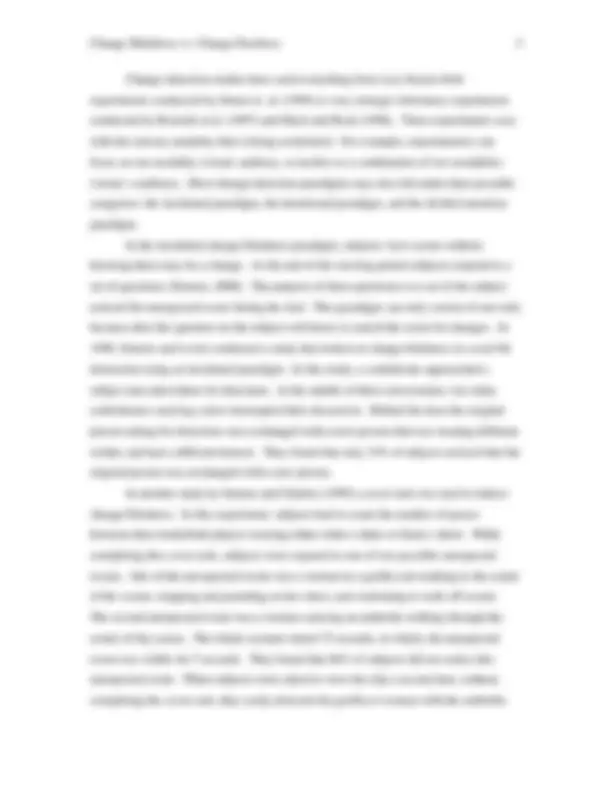
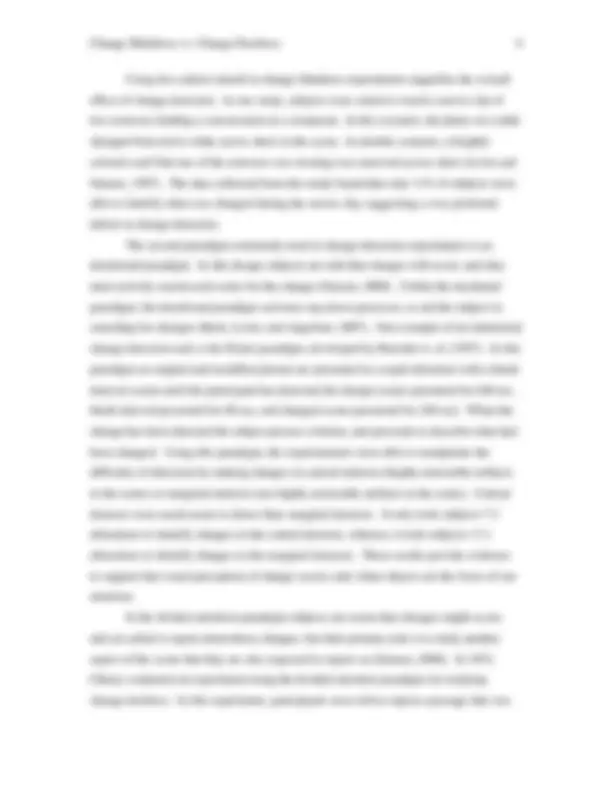
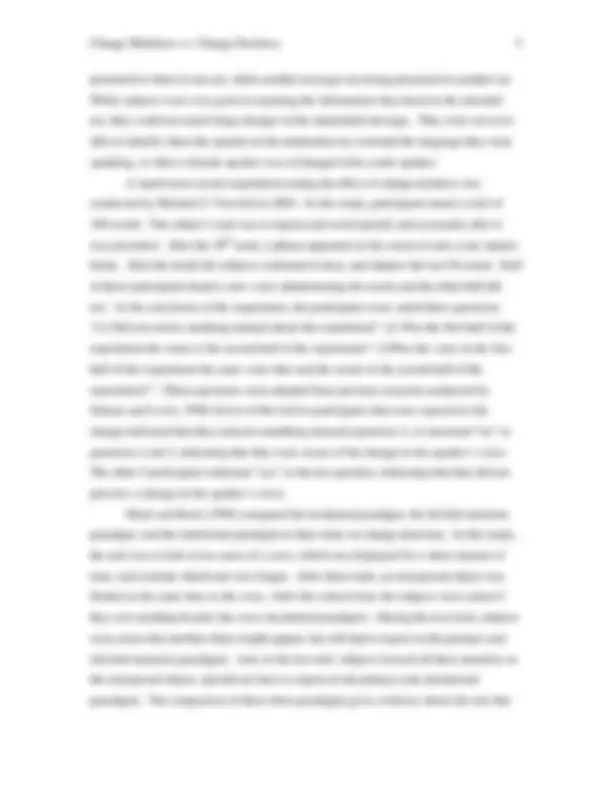
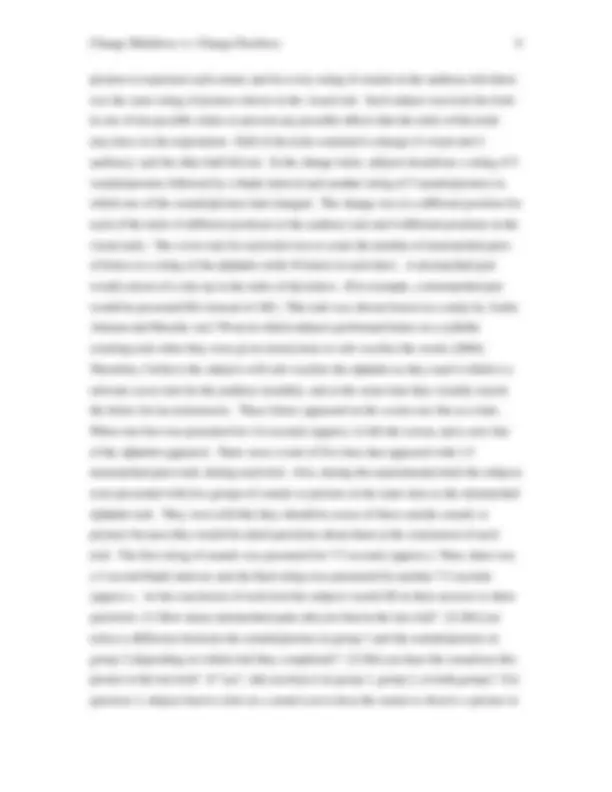
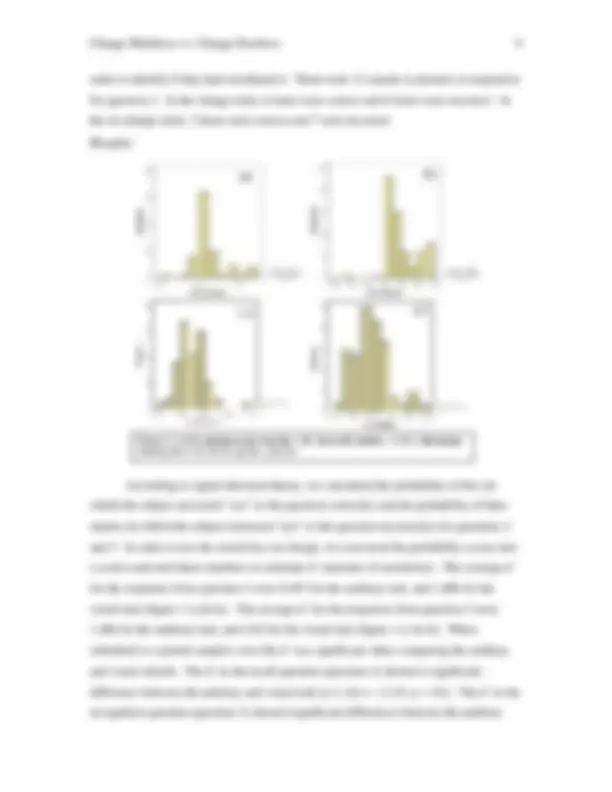
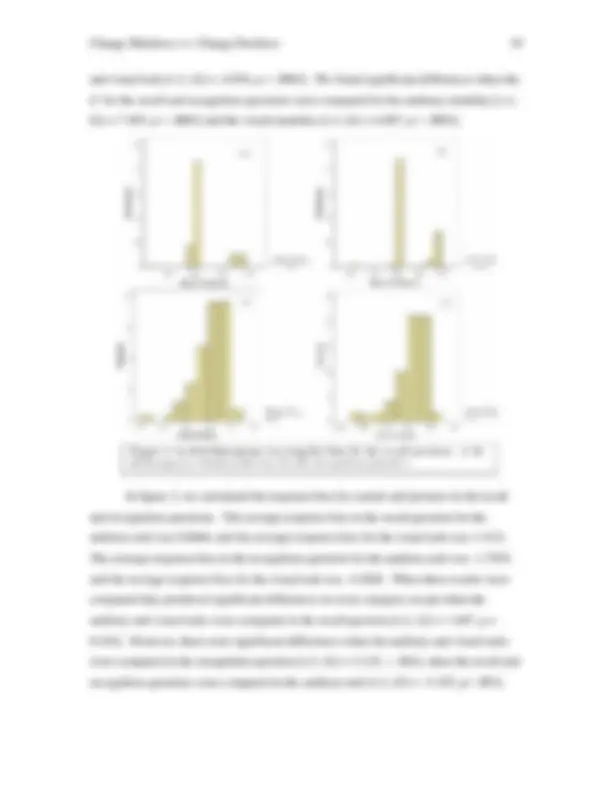
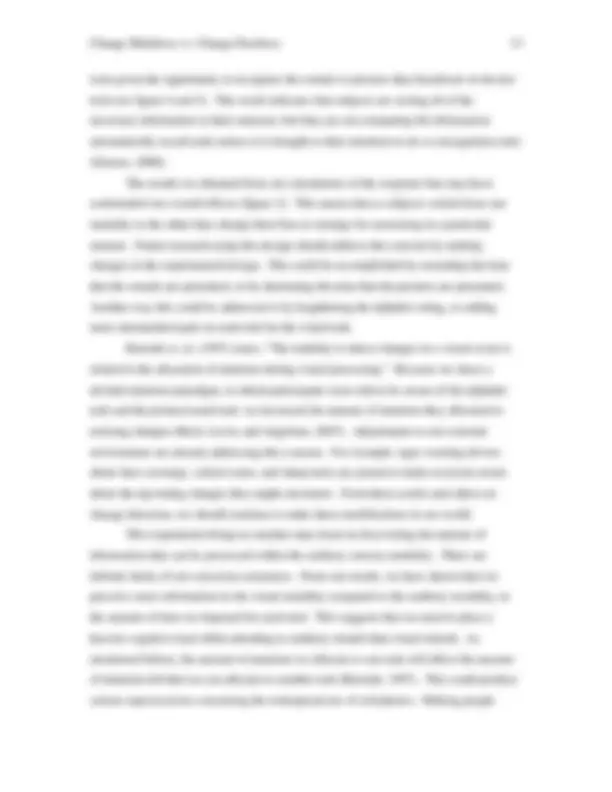
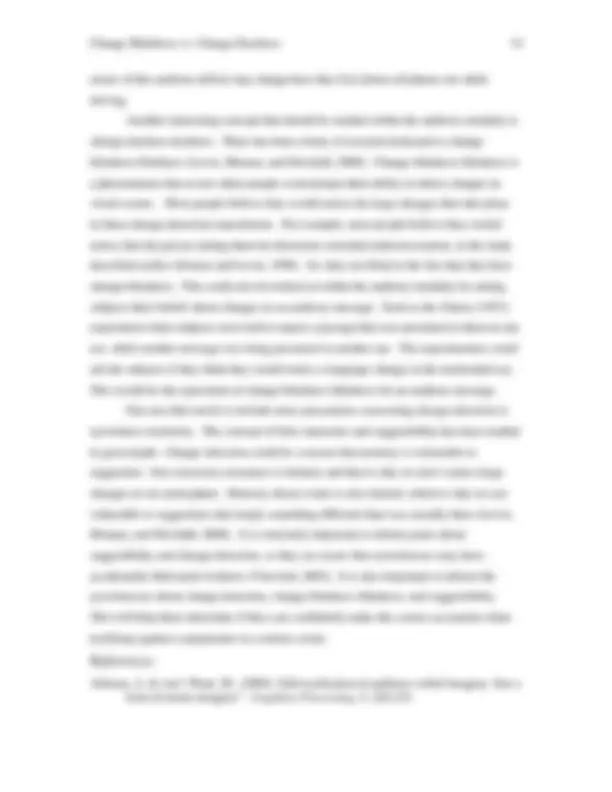
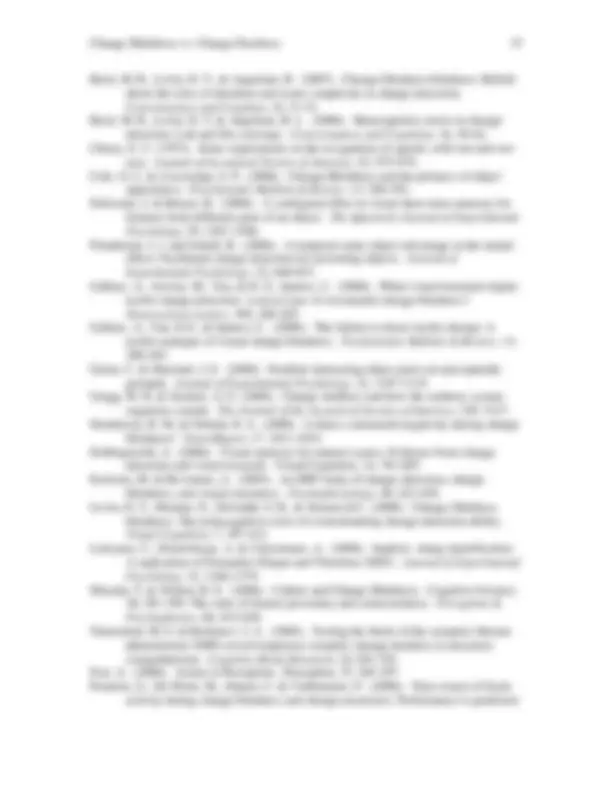


Study with the several resources on Docsity

Earn points by helping other students or get them with a premium plan


Prepare for your exams
Study with the several resources on Docsity

Earn points to download
Earn points by helping other students or get them with a premium plan
Community
Ask the community for help and clear up your study doubts
Discover the best universities in your country according to Docsity users
Free resources
Download our free guides on studying techniques, anxiety management strategies, and thesis advice from Docsity tutors
The phenomena of change blindness and change deafness, two conditions that affect our ability to detect sensory changes in the visual and auditory modalities respectively. The study, conducted by Crystal Smith under the guidance of Dr. Janine Wotton at Gustavus Adolphus College, compares the two conditions based on various change detection paradigms and their implications for our understanding of perception. The document also discusses the role of attention in change detection and its impact on the overall effect.
What you will learn
Typology: Study notes
1 / 16

This page cannot be seen from the preview
Don't miss anything!










Change blindness is a well documented phenomenon that occurs when subjects are unable to detect changes within the visual sensory modality. Change deafness, however, is much less understood, and occurs when changes within the auditory sensory modality go unnoticed. Our study is looking at the similarities and differences between these two phenomena using a similar paradigm. In this paradigm, subjects were given a primary task of counting the number of mismatched letters in lines of the alphabet. While completing this task, they were presented with two groups of sounds or pictures. In half of the trials, there was a change in the picture/sound from group one to group two. Our results show that change deafness occurred to a greater degree than change blindness, and subjects were better at recognizing that a change occurred than recalling that change.
Imagine you are sitting on the witness stand testifying in the case of a missing child. During the alleged abduction you were sitting in a park enjoying a good novel. In the background there was a child swinging on a nearby swing set. As you are reading, a man walks over to the swing set and picks up the child without drawing your attention. Shortly afterward, a frantic mother approaches and asks if you have seen her child. You are now facing a jury and your ability to identify the perpetrator relies on your eyewitness testimony. Would you be able to confidently make the correct accusation? This paper will discuss our ability to notice large changes, such as this, in our sensory environment. Change detection is a widely researched phenomenon that examines our ability to perceive changes in our external environment. The majority of change detection studies have looked at changes in visual scenes, but a few studies have also looked at change detection in the auditory and tactile modalities. The results of these studies are all quite similar. For the most part, they conclude that we are very poor at detecting changes in the presented stimuli. The term, change blindness, has been coined to describe our poor ability at detecting changes in our visual environment, whereas, change deafness is used to refer to our deficit in detecting changes in our auditory environment. A large amount of very intriguing research has been reported in support of these two sensory phenomena.
Using less salient stimuli in change blindness experiments magnifies the overall effect of change detection. In one study, subjects were asked to watch a movie clip of two actresses holding a conversation in a restaurant. In this scenario, the plates on a table changed from red to white across shots in the scene. In another scenario, a brightly colored scarf that one of the actresses was wearing was removed across shots (Levin and Simons, 1997). The data collected from this study found that only 11% of subjects were able to identify what was changed during the movie clip, suggesting a very profound deficit in change detection. The second paradigm commonly used in change detection experiments is an intentional paradigm. In this design subjects are told that changes will occur, and they must actively search each scene for the change (Simons, 2000). Unlike the incidental paradigm, the intentional paradigm activates top-down processes, to aid the subject in searching for changes (Beck, Levin, and Angelone, 2007). One example of an intentional change detection task is the flicker paradigm, developed by Rensink et. al. (1997). In this paradigm an original and modified picture are presented in a rapid alteration with a blank interval screen until the participant has detected the change (scene presented for 240 ms, blank interval presented for 80 ms, and changed scene presented for 240 ms). When the change has been detected the subject presses a button, and proceeds to describe what had been changed. Using this paradigm, the experimenters were able to manipulate the difficulty of detection by making changes in central interests (highly noticeable artifacts in the scene) or marginal interests (not highly noticeable artifacts in the scene). Central interests were much easier to detect than marginal interests. It only took subjects 7. alterations to identify changes in the central interests, whereas, it took subjects 17. alterations to identify changes in the marginal interests. These results provide evidence to support that visual perception of change occurs only when objects are the focus of our attention. In the divided attention paradigm subjects are aware that changes might occur, and are asked to report about those changes, but their primary task is to study another aspect of the scene that they are also expected to report on (Simons, 2000). In 1953, Cherry conducted an experiment using the divided attention paradigm for studying change deafness. In this experiment, participants were told to repeat a passage that was
presented to them in one ear, while another message was being presented in another ear. While subjects were very good at repeating the information they heard in the attended ear, they could not report large changes in the unattended message. They were not even able to identify when the speaker in the unattended ear switched the language they were speaking, or when a female speaker was exchanged with a male speaker. A much more recent experiment testing the effect of change deafness was conducted by Micheal S. Vitevitch in 2003. In this study, participants heard a total of 100 words. The subject’s task was to repeat each word quickly and accurately after it was presented. After the 50th^ word, a phrase appeared on the screen to take a one minute break. After the break the subjects continued to hear, and shadow the last 50 words. Half of these participants heard a new voice administering the words and the other half did not. At the conclusion of the experiment, the participants were asked three questions: “(1) Did you notice anything unusual about the experiment? (2) Was the first half of the experiment the same as the second half of the experiment? (3)Was the voice in the first half of the experiment the same voice that said the words in the second half of the experiment?” (These questions were adapted from previous research conducted by Simons and Levin, 1998) Seven of the twelve participants that were exposed to the change indicated that they noticed something unusual (question 1), or answered “no” to questions 2 and 3, indicating that they were aware of the change in the speaker’s voice. The other 5 participants indicated “yes” to the last question, indicating that they did not perceive a change in the speaker’s voice. Mack and Rock (1998) compared the incidental paradigm, the divided attention paradigm, and the intentional paradigm in their study on change detection. In this study, the task was to look at two arms of a cross, which was displayed for a short amount of time, and evaluate which arm was longer. After three trials, an unexpected object was flashed at the same time as the cross. After this critical trial, the subjects were asked if they saw anything besides the cross (incidental paradigm). During the next trial, subjects were aware that another object might appear, but still had to report on the primary task (divided attention paradigm). And, in the last trial, subjects focused all their attention on the unexpected object, and did not have to report on the primary task (intentional paradigm). The comparison of these three paradigms gives evidence about the role that
change deafness will produce a larger effect than change blindness, because we rely on our visual system more than our auditory system. This study will also examine the difference between recalling a change and recognizing the same change in an identification task. We think subjects will perform better on the recognition task than the recall task. I believe this will occur because we are unable to make judgments about every aspect of our environment due to the limited capacity of our attention. However, by employing a recognition task we are activating a cognitive process that requires them to evaluate exactly what they saw and what they did not see.
Participants: A group of 6 undergraduate students participated in a preliminary study to test the accuracy of the stimuli. Another group of 63 undergraduate psychology students from a small liberal arts college in the midwest participated in our primary study. All of the subjects were offered course credit for participating in this study. Stimuli: A collection of 44 wav files were obtained from various wav file websites. (ex: school bell, laser, shotgun, bee, kiss, splash, sneeze, elephant, etc.) These wav files were modified to a sampling frequency of 10,000 Hz, convolved in groups of two (one sound in each group was not convolved) and concatenated to form a string of five sounds played continuously without overlap (7.22 seconds to 7.72 seconds long) using Praat. These sounds were presented in their string form during each trial and in their individual form during the recognition task. Another group of 44 pictures were obtained from various clip art websites. Each of the pictures had a matching sound. (ex: buzzing of the bee was matched with a picture of a bee) Microsoft® PowerPoint 2003© was used to present the stimuli to the participants. The custom animation feature of PowerPoint 2003 allowed us to time the alphabet task with the picture/sound task. The subjects completed the experiment at their own computer station and wore headphones to prevent any background distractions from affecting the data. The computer was set at the same audible volume for all of the participants. Procedure: A divided attention paradigm was used in this study. The design was a 2x (auditory or visual modality, change or no change condition). Each participant had to complete 16 trials, 8 with the auditory stimuli and 8 with the visual stimuli. The stimuli for the visual task mimicked the stimuli for the auditory task exactly. There were
pictures to represent each sound, and for every string of sounds in the auditory trial there was the same string of pictures shown in the visual trial. Each subject received the trials in one of ten possible orders to prevent any possible effects that the order of the trials may have on the experiment. Half of the trials contained a change (4 visual and 4 auditory), and the other half did not. In the change trials, subjects heard/saw a string of 5 sounds/pictures followed by a blank interval and another string of 5 sounds/pictures in which one of the sounds/pictures had changed. The change was in a different position for each of the trials (4 different positions in the auditory task and 4 different positions in the visual task). The cover task for each trial was to count the number of mismatched pairs of letters in a string of the alphabet (with 10 letters in each line). A mismatched pair would consist of a mix up in the order of the letters. (For example, a mismatched pair would be presented BA instead of AB.) This task was chosen based on a study by Andre Aleman and Mascha van’t Wout in which subjects performed better on a syllable counting task when they were given instructions to sub-vocalize the words (2004). Therefore, I believe the subjects will sub-vocalize the alphabet as they read it which is a relevant cover task for the auditory modality, and at the same time they visually search the letters for inconsistencies. These letters appeared on the screen one line at a time. When one line was presented for 3.6 seconds (approx.) it left the screen, and a new line of the alphabet appeared. There were a total of five lines that appeared with 3- mismatched pairs total, during each trial. Also, during the experimental trials the subjects were presented with two groups of sounds or pictures at the same time as the mismatched alphabet task. They were told that they should be aware of these outside sounds or pictures because they would be asked questions about them at the conclusion of each trial. The first string of sounds was presented for 7.5 seconds (approx.). Then, there was a 3 second blank interval, and the final string was presented for another 7.5 seconds (approx.). At the conclusion of each trial the subjects would fill in their answers to three questions: (1) How many mismatched pairs did you find in the last trial? (2) Did you notice a difference between the sounds/pictures in group 1 and the sounds/pictures in group 2 (depending on which trial they completed)? (3) Did you hear this sound/see this picture in the last trial? If “yes”, did you hear it in group 1, group 2, or both groups? For question 3, subjects had to click on a sound icon to hear the sound or observe a picture in
and visual task [t (1, 62) = -4.954, p < .0001]. We found significant differences when the d’ for the recall and recognition questions were compared for the auditory modality [t (1,
In figure 2, we calculated the response bias for sounds and pictures in the recall and recognition questions. The average response bias in the recall question for the auditory task was 0.6866, and the average response bias for the visual task was 1.3121. The average response bias in the recognition question for the auditory task was -1.7939, and the average response bias for the visual task was -4.2026. When these results were compared they produced significant differences in every category except when the auditory and visual tasks were compared in the recall question [t (1, 62) = 1.667, p = 0.101]. However, there were significant differences when the auditory and visual tasks were compared in the recognition question [t (1, 62) = 5.135, < .001], when the recall and recognition questions were compared in the auditory task [t (1, 62) = -5.103, p< .001],
and when the recall and recognition questions were compared in the visual task [t (1, 62) = -6.628, p < .001].
Figure 3 is representing the signal detection matrix for the response probabilities taken from the recall question. After running paired samples t-tests on the probabilities, we did not find a significant difference between the number of hits and the number of misses for the sound modality [t (1, 62) = 1.357, p = 0.18]. However, we did find a significant difference between the number of hits and the number of misses in the visual modality [t (1, 62) = 4.280, p < .0001]. You can also note, in figure 3, that the amount of correct rejections exceeds the amount of hits, however this statistic is not significant for the auditory task [t (1, 62) = -1.368, p = .176] or the visual task [t (1, 62) = -1.464, p = .148]. Figure 4 is showing the response probabilities from the recognition task. We found a significant difference when comparing the probabilities between the hit and miss conditions for the picture task and the auditory task; [t (1, 62) = 14.238, p < .001] and [t (1, 62) = 8.217, p < .001]. We also found significant differences between the hit and correct rejection conditions for the auditory and visual task; [t (1, 62) = -10.877, p < .001] and [t (1, 62] = -7.345, p < .001]. Our last figure represents the response probabilities for the recall question compared to the response probabilities of the recognition question. In order to run statistical analyses between these two questions we converted everything into z-scores. We found significant differences between the hit conditions of recall and recognition for the auditory and visual task [t (1, 62) = -10.586, p < .001] and [t (1, 62) = -13.952, p <
were given the opportunity to recognize the sounds or pictures they heard/saw in the last trial (see figure 4 and 5). This result indicates that subjects are storing all of the necessary information in their memory; but they are not comparing the information automatically (recall task) unless it is brought to their attention to do so (recognition task) (Simons, 2000). The results we obtained from our calculations of the response bias may have confounded our overall effects (figure 2). This means that as subjects switch from one modality to the other they change their bias or strategy for answering in a particular manner. Future research using this design should address this concern by making changes in the experimental design. This could be accomplished by extending the time that the sounds are presented, or by shortening the time that the pictures are presented. Another way this could be addressed is by lengthening the alphabet string, or adding more mismatched pairs in each trial for the visual task. Rensink et. al. (1997) states, “The inability to detect changes in a visual scene is related to the allocation of attention during visual processing.” Because we chose a divided attention paradigm, in which participants were told to be aware of the alphabet task and the picture/sound task, we increased the amount of attention they allocated to noticing changes (Beck, Levin, and Angelone, 2007). Adjustments to our external environment are already addressing this concern. For example, signs warning drivers about deer crossings, school zones, and sharp turns are posted to make everyone aware about the upcoming changes they might encounter. From these results and others on change detection, we should continue to make these modifications in our world. This experiment brings us another step closer in discovering the amount of information that can be processed within the auditory sensory modality. There are definite limits of our conscious awareness. From our results, we have shown that we perceive more information in the visual modality compared to the auditory modality, in the amount of time we imposed for each trial. This suggests that we need to place a heavier cognitive load while attending to auditory stimuli than visual stimuli. As mentioned before, the amount of attention we allocate to one task will affect the amount of attention left that we can allocate to another task (Rensink, 1997). This could produce serious repercussions concerning the widespread use of cell phones. Making people
aware of this auditory deficit may change how they feel about cell phone use while driving. Another interesting concept that should be studied within the auditory modality is change deafness deafness. There has been a body of research dedicated to change blindness blindness (Levin, Momen, and Drivdahl, 2000). Change blindness blindness is a phenomenon that occurs when people overestimate their ability to detect changes in visual scenes. Most people believe they would notice the large changes that take place in these change detection experiments. For example, most people believe they would notice that the person asking them for directions switched midconversation, in the study described earlier (Simons and Levin, 1998). So, they are blind to the fact that they have change blindness. This could also be looked at within the auditory modality by asking subjects their beliefs about changes in an auditory message. Such as the Cherry (1953) experiment when subjects were told to repeat a passage that was presented to them in one ear, while another message was being presented in another ear. The experimenters could ask the subjects if they think they would notice a language change in the unattended ear. This would be the equivalent of change blindness blindness for an auditory message. One area that needs to include more precautions concerning change detection is eyewitness testimony. The concept of false memories and suggestibility has been studied in great depth. Change detection could be a reason that memory is vulnerable to suggestion. Our conscious awareness is limited, and that is why we don’t notice large changes in our atmosphere. Memory about events is also limited, which is why we are vulnerable to suggestions that imply something different than was actually there (Levin, Momen, and Drivdahl, 2000). It is extremely important to inform juries about suggestibility and change detection, so they are aware that eyewitnesses may have accidentally fabricated evidence (Vitevitch, 2003). It is also important to inform the eyewitnesses about change detection, change blindness blindness, and suggestibility. This will help them determine if they can confidently make the correct accusation when testifying against a perpetrator in a serious crime.
Aleman, A. & van’t Waut, M. (2004). Subvocalization in auditory-verbal imagery: Just a form of motor imagery? Cognitive Processing, 5, 228-231.
by neural events before change onset. Journal of Cognitive Neuroscience , 18, 2108-2129. Roda, C. & Thomas, J. (2006). Attention aware systems: Theories, applications, and research agenda. Computers in Human Behavior, 22, 557-587. Scholl, B. J., & Simons, D. J. (2001). Change blindness, Gibson, and the sensorimotor theory of vision. Behavioral and Brain Sciences , 24, 1004-1006. Simons, D. J. (2000). Current approaches to change blindness. Visual Cognition , 7, 1-
Simons, D. J. & Ambinder, M. S. (2005). Change Blindness: Theory and Consequences. Current Directions in Psychological Science , 14, 44-48. Simons, D. J., & Chabris, C. F. (1999). Gorillas in our midst: sustained inattentional blindness for dynamic events_. Perception_ , 28, 1059-1074. Sinnett, S., Costa, A., & Soto-Faraco, S. (2006). Manipulating inattentional blindness within and across sensory modalities. The Quarterly Journal of Experimental Psychology , 59, 1425-1442. Smilek, D., Eastwood, J. D., Reynolds, M. G. & Kingstone, A. (2007). Metacognitive errors in change detection: Missing the gap between lab and life. Consciousness and Cognition , 16, 52-57. Rensink, R. A., O’Regan, J. K., & Clark, J. J. (1997). To see or not to see: The need for attention to perceive changes in scenes. Psychological Science , 8, 368-373. Vitevitch, M. S. (2001). Change deafness: The inability to detect changes in a talker’ voice. The Journal of the Acoustical Society of America , 109, 2312. Vitevitch, M.S. (2003). Change Deafness: The inability to detect changes between two voices_. Journal of Experimental Psychology_ , 29, 333-342. Wayand, J.F., Levin, D. T., & Varakin, A. (2005). Inattentional blindness for a noxious multimodal stimulus, American Journal of Psychology , 118, 339-352. Wolfe, J. M., Reinecke, A. & Brawn, P. (2006). Why don’t we see changes? The role of attentional bottlenecks and limited visual memory. Visual Cognition , 14, 749-